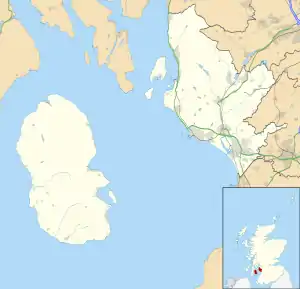Sannox
Sannox (Scottish Gaelic: Sannaig) is a village on the Isle of Arran, Scotland. The village is within the parish of Kilbride.[1] The name comes from the name the Vikings gave to the area, Sandvik, meaning the Sandy Bay.
Sannox
| |
|---|---|
 Sannox Bay in 2011 | |
 Sannox Location within North Ayrshire | |
| OS grid reference | NS015455 |
| Civil parish |
|
| Council area | |
| Lieutenancy area | |
| Country | Scotland |
| Sovereign state | United Kingdom |
| Post town | ISLE OF ARRAN |
| Postcode district | KA27 |
| Dialling code | 01770 |
| Police | Scotland |
| Fire | Scottish |
| Ambulance | Scottish |
| UK Parliament | |
| Scottish Parliament | |
History
Within Glen Sannox it is possible to find an Iron Age fort and the remains of a village, abandoned in 1829 as part of the process of the Highland clearances. Most of the inhabitants of this village emigrated to Canada where they built a replica of the church that was constructed in Sannox in 1822. The replica church in Inverness, Quebec, is no longer there (since the 1950s) and only the cemetery remains.
Mining was a source of employment in the area, when in 1840 a mine was opened in the area. However operations only lasted around two decades. Operations ended when in 1862 the 11th Duke of Hamilton closed the mine, claiming that it spoiled the local area. However, the mine was reopened after the close of the First World War, and a railway and pier were built to transport the barytes that was mined there.
The source of barytes ran out in 1938 and the mine closed. The railway and pier were removed in the 1940s.
Geography
Sannox sits on the east coast of the Isle of Arran, with a stunning backdrop of scenery in the shape of Glen Sannox.
Community
Sannox is the location of the Corrie Golf Club,[2] a nine-hole golf course, named after the locally twinned village of Corrie. It has a few guest houses/B&Bs, as well as the Sannox Bay hotel and restaurant. It is also the location of Sannox Cricket Club.
References
- "Details of Sannox". Scottish Places. Retrieved 30 December 2014.
- "Arran, Mid Sannox, Corrie Golf Course". Canmore. Royal Commission on the Ancient and Historical Monuments of Scotland. Retrieved 30 December 2014.
External links
| Wikimedia Commons has media related to Sannox. |
- Canmore - Sannox Bay, Standing Stone site record
- Canmore - Arran, Sannox Congregational Church site record
